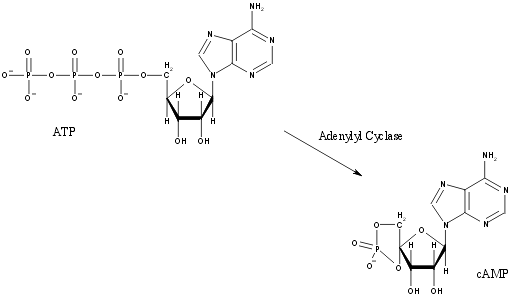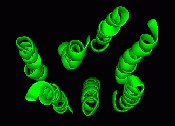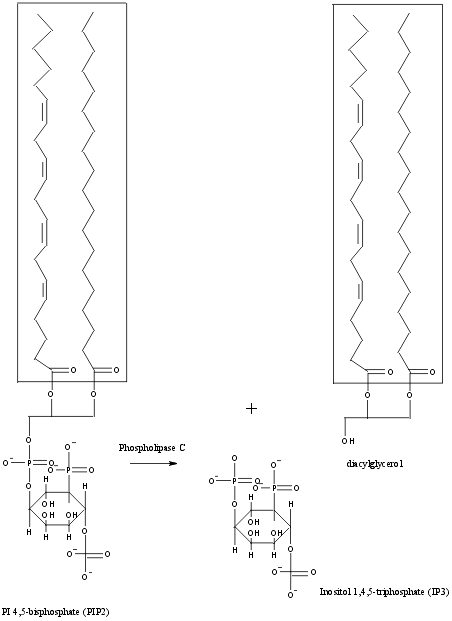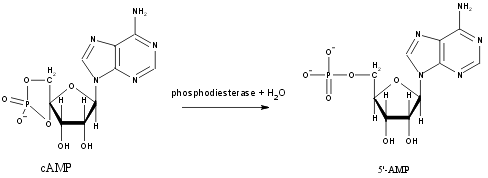MODE OF ACTION:
Several studies have suggested an association between Beta agonist use and an increased risk of death from asthma.28,29 Proposed mechanisms include increased bronchial hyperresponsiveness, drug tolerance or an underlying increased severity of disease. The resulting controversy has stimulated multiple studies. Such analyses support the continued use of salbutamol as a first-line therapy for the treatment of asthma.30,31. This apparent controvosy appears to be due to the two different isomers have opposing effects. R-salbutamol causes smooth muscle to relax whereas S-salbutamol causes smooth muscle to contract. The two isomers act on different receptors and thus on different pathways resulting in the opposing effects.
R-Salbutamol:
R-Salbutamol acts on Beta 2 Adrenergic Receptors (three
dimensional structure). These receptors are found on the smooth muscle
lining airways of the lungs. The binding or R-salbutamol to this receptor
causes a conformational change in the protein. Beta 2 adrenergic receptors
are an example of a G linked protein, the receptor has seven trans membrane
domains and is associated in the membrane with a G protein. The G protein
has three sub units (an alpha sub unit and a tightly associated beta and
gamma sub units).
The conformational change in the beta 2 receptor causes the beta 2
receptor to bind to a G protein and this in tern causes a conformation
change in the G protein. A GDP (guanosine 5'-diphosphate) group associated
with the G protein becomes dissociated and is then replaced with a GTP
(guanosine 5'-triphosphate) group. This in turn causes the alpha sub unit
to dissociate from the G complex. The dissociated alpha sub unit is then
free to move in the membrane and has a binding site for the enzyme adenylyl
cyclase. It binds to an adenylyl cyclase (three
dimensional structure) and activates it. This enzyme catalyses the
conversion of ATP to cAMP (adenosine 5'-triphosphate to adenosine 3',5'-monophosphate)32:

cAMP levels in the cell therefore increase due to the additional adenylyl cyclase produced by the binding of R-salbutamol. cAMP activates protein kinase A (a cyclic AMP dependent protein kinase). Protein kinase A transfers the terminal phosphate group of an ATP to several target proteins within the cell which leads to muscle relaxation.
The phosphorylation process leads to muscle relaxation by several processes including
- active removal of Ca2+ ions from the cell and into intracellular stores, thus lowering intracellular Ca2+ ion concentration. Ca2+
- inhibition of phosphoinositide hydrolysis
- direct inhibition of of myosin light chain kinase
- opening of calcium activated potassium channels that repolarises smooth muscle cells.
Thus R-salbutamol can cause muscle relaxation irrespective of the method of initiation of the muscle contraction (the contractile agent, be it neural or mediated). As asthma is caused by many different contributions leading to muscle contraction and makes salbutamol a suitable drug for its treatment.
R salbutamol also has several other beneficial effects on the lungs (other than smooth muscle relaxation):
- Inhibition of mast cell mediator release
- Increases mucous secretion
- Increased clearing of the mucus by the action of cilia
But R-salbutamol has no effect on chronic inflammation but the inhibition
of mast cell mediator release is anti-inflammatory and thus salbutamol
can to an extent also modify acute inflammation, another symptom of asthma..
S-Salbutamol:
S-salbutamol is now thought to be the main cause of bronchial
hyper responsiveness in the treatment of asthma with salbutamol.
S-salbutamol acts on muscarinic receptor receptors. These are also
G linked proteins and also have seven trans membrane domains: PDB
of seven trans membrane domains,[26]:

Being a G linked protein the conformational changes and the dissociation of the alpha sub unit is identical to that of the beta two receptor. However the alpha sub unit activates a different enzyme in this pathway. In this pathway the alpha sub unit activates phospholipase C. This enzyme catalyses the phosphorylation of phosphatidylinositol 4,5-bisphosphate (PIP2) to inositol 1,4,5-triphosphate (IP3) on the inside of the membrane. Phosphatidylinositol 4,5-bisphosphate (PIP2) is a membrane bound structure formed in the following manner:

The PIP2 is then hydrolysed by phospholipase C to inositol 1,4,5-triphosphate (IP3).

METABOLISM:
Studies have found peak plasma concentrations occur approximately 2-5 hours after inhalation and 2-2.5 hours after ingestion. Salbutamol is metabolized in the liver, mainly by conjugation to the inactive salbutamol-4'-0-sulphate. Salbutamol's plasma half life is reportedly 2.7-5 hours after oral administration. The half life has been indirectly estimated through urine excretion studies to be 3.8 hours after inhalation. Unchanged drug and metabolite are 72% excreted in the urine within the first 24 hours.26
R-salbutamol: metabolism of cAMP
Cyclic AMP is degraded by hydrolysis by the enzyme phophodiesterase:

S-salbutamol: metabolism of IP3
two methods operate to terminate the initial Ca2+ response.
- IP3 itself is rapidly dephosphorylated by specific phosphateses
- Ca2+ is pumped out of the cell but the sodium potassium pump.